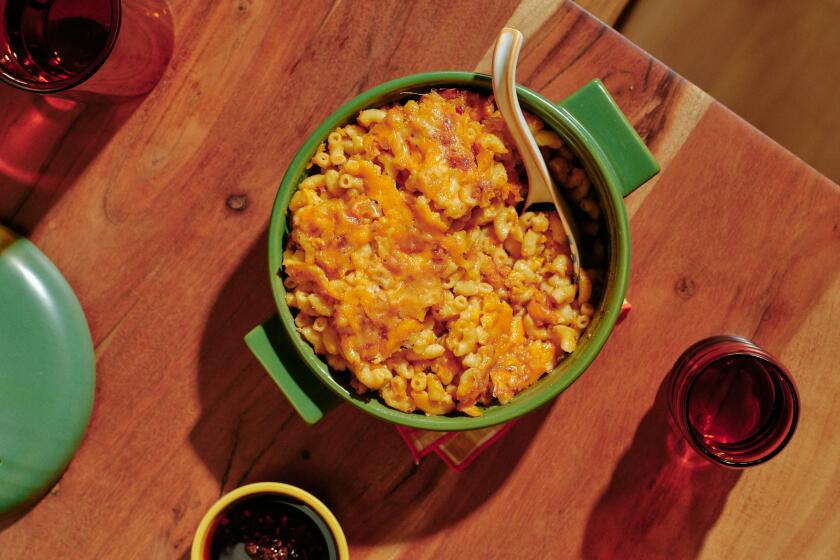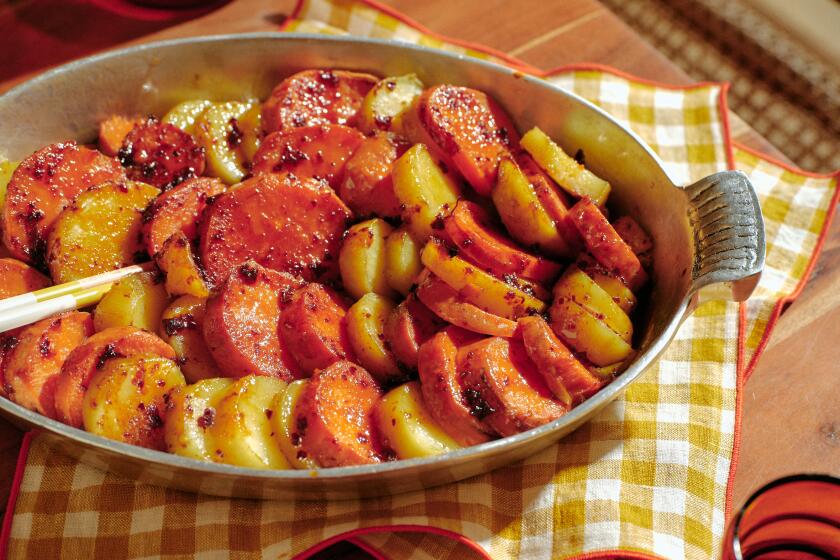Parsnip-apple hash

Wenatchee, Wash.
Walk into the gift shop of the Washington State Apple Commission, and you see red. Just about everything carries a Red Delicious motif. There are Red Delicious postcards, Red Delicious doormats, Red Delicious T-shirts, even images of Red Delicious apples erupting out of American flags.
Yet leave the commission, tour the surrounding countryside, and farmers are firing up their buzz saws, felling and burning Red Delicious orchards as fast as they can raise the money to replant them. During the last four years, some 60,000 acres of Red Delicious have been replaced with new varieties that don’t just look nice, they taste good. Sweetness, spice, juiciness and a rowdy autumn crunch have all returned to Washington apples.
We weren’t wrong to think that these qualities were lost. For the better part of 20 years, from the early 1970s to the late ‘80s, apples fell from paradise. Good apples became so rare that some of us wondered if we’d imagined the spicy and bright fruit of our childhoods. We hadn’t. New Yorkers really had developed a passion for the almost painfully tart Winesaps, Missourians loved the sweet Jonathans, Northern Californians the heady, old world aromatics of Gravensteins.
Those who knew the original Delicious apple before it became unrecognizably red and the emblem of every packing house in Washington, even missed that. Originally called the Hawkeye, this real Delicious came out of Iowa, where a farmer failed to kill it after accidentally mowing it down several times. It was subsequently picked up by a prominent nursery, declared to be Delicious, and heavily promoted in the newly developing western apple regions as the Next Big Thing.
And it was a very respectable apple, says Washington State University flavor chemist John Fellman. He and Preston Andrews, a WSU horticulturist, lead a tour of the university’s research orchard, where more than 100 historic varieties of apples grow. Locals pay to pick their own here. It may be the only pick-your-own orchard selling Yellow Newtowns, the type that Ben Franklin had shipped to himself in London. Fellman plucks a striped apple with a faintly yellow background and tosses it to me.
“That’s a Red Delicious,” he says. It sure doesn’t look like one. Red Delicious apples, explains Fellman, were not always so deeply, uniformly red. I bite it. It’s sweet, with firm almost-cream-colored flesh with good perfume.
By contrast, the commodity fruit known as Red Delicious are “sports,” says Fellman, mutations promoted in an unending quest for redness. Packing houses grade by color, and began offering premiums for the reddest specimens. Sharp-eyed farmers spotted branches bearing particularly red fruit and propogated them. Eventually more than 100 sports were developed into the red, redder and reddest commercial varieties that we know today.
As the Red Delicious started looking less like itself and more like something out of “Snow White,” Fellman began studying the pigments and found the darker they got, the more bitter the skin. He warned apple producers, but they didn’t listen. The line from packers was: They’d never had a box of apples returned because they didn’t taste good.
The New Zealand invasion
By the late 1980s, the industry had just about every horticulturalist in Washington worried sick. The state’s leading farm advisor, Kathleen Willemsen, alerted them to a wave of new varieties from New Zealand appearing in supermarkets. These imports were even selling in Washington. Even out of cold store, their scent and snap awoke dormant memories of good eating apples.
Willemsen was impressed by the new breeds, and went to New Zealand to study them. The Braeburns were tart, a sharp reminder of apples past for Winesap lovers, while the Gala was an aromatic cross between the perfectly luscious yellow American apple, the Golden Delicious, and the most revered aromatic apple of England, the English Cox Orange Pippin. She pointed to the island nation raiding their markets. The Red Delicious growers ignored her.
By 1998, after 10 years of the New Zealand incursion, WSU horticulturalist Bruce Barritt was beside himself with frustration at the growers. He railed that if they didn’t start breeding for taste, for the eating pleasure of consumers, they would be out of business.
Almost instantly, he was proven right. At the time, 60% of the state’s apple crop was devoted to Red Delicious. A third of Washington production went to the Far East. The Asian market collapsed and more than 20% of Washington apple growers were swept away.
A chastened, bruised industry came to Barritt. The state clearly needed new apples, tasty ones, but the most extensive breeding program was 3,000 miles away, at Cornell University in Geneva, N.Y. This research station had already given the world a succession of new apples, including the Empire and the highly regarded Jonagold. Barritt’s dream for Washington growers was the Northwest equivalent of a Jonagold, a calling card fruit for the apple state.
In the last four years, Barritt has planted more than 15,000 seedlings outside the USDA offices in Wenatchee in a sort of star search for fruit. The morning he meets me, he’s in a hurry. He’s got a tour coming shortly. That, and “We’re 25 years behind!” he cries.
Charging down a row of a test orchard, Barritt picks red apples, yellow apples, gold apples, crimson apples, orange apples, taking a bite from each. He doesn’t like any of them. “Ah, tough! It’s a spitter!” he cries at the worst.
Inside his lab, tables are covered with trays of apples, dozens of them, each with tags next to them, and most with bites missing. Two technicians are busy biting, spitting and scoring each apple. On their clipboard check sheets there are grades for appearance, from “ugly” to “beautiful,” eating quality from “yuck” to “outstanding,” and overall score from “reject” to “advance to stage 2”. Barritt gives me several to taste. There are apples that taste like bananas, like pears, like anise. The last one is as acidic as a lime. He knows it. It’s a trick. He erupts in laughter.
What they’re looking for is an apple that has it all: perfume, crispness, juiciness, color and disease resistance.
From 15,000 seedlings, he says, “We might get 150 that are reasonable. From those, there might be one that will someday go into production.” Even fast-tracked, a new apple won’t come out of Washington for 10 to 15 years. You realize that apple breeding is the fruit equivalent of having tens of thousands of children until you produce a Mozart.
New varieties take root
As Washington plays catch-up with rival breeders, its farmers are already searching for flavor. Ray Fuller has been looking to Canada, to the sweet Ambrosias bred there, and to Minnesota, to their Honeycrisps, to see if these sweet apples with a Fuji-like snap might do well for him. Fuller is a second-generation apple farmer with 100 acres in the north of the state, above Lake Chelan. He was brought up in the Red Delicious school. But when he began to manage the family farm in 1979, he decided the best way to preserve it was to modernize. In 1983, three years before the Alar scare and 15 years before the organic vogue, Fuller converted the farm to organic.
Next he started ripping out Red Delicious and putting in apples that would ripen in sweet succession: Gingergold in August, Gala in early September, then Ambrosia, and Honeycrisp through mid-October.
Fuller dispensed with old planting systems, in which 109 trees were planted per acre, spaced widely, allowed to grow tall. These looked pretty, but took forever to bear fruit and were difficult to pick. He moved to intensive espalier systems on dwarf rootstocks, where the trees look more like hops than apples.
The cost? “Horrendous,” says Fuller. University guides put them at $12,000 to $17,000 an acre. This year, as his trees finally start yielding, after three years of losses, he hopes to make a profit.
Fuller is also proud of his packing house, Stemilt, one of the few in the state to run a dedicated line for organic apples. At dawn the next day, Stemilt sales manager Roger Pepperl offers a tour of the main plant, a virtual city consisting of water washes, conveyor belts, grading tables. Here apples are washed, pre-graded, washed again, rinsed, dried, polished. Apples rolling along conveyor belts are graded for variety, then size, then color.
There is even a new gizmo that shoots halogen into apples to determine their sweetness and freshness. This machine isn’t just the talk of greater Wenatchee: Cornell apple breeder Susan Brown says if this machine is adopted as an industry standard, it could make the mealy apple a thing of the past.
The science of the bite
One hundred miles south, in Yakima, Allan Bros. is typical of future firms: packer-farmers. The company is run by George and David Allan, then a posse of Allan sons and cousins. Between the small army of Allans, they have 700 trees. Ten years ago, they were nearly all Red Delicous. Now, all but 20% have been replaced with Gala, Braeburn, Granny Smith, Golden Delicious. They’re on the verge of paying license fees to grow brand new varieties coming out of New Zealand called Pacific Rose and Jazz.
On the packing line, David Allan shows how the packhouse stickers will soon identify the farmer, harvest date, pack date, sugar level. “If an apple’s bad, even though we’re thousands of miles away, consumers will be able to find us,” says Todd Allan. “There’ll be nowhere to hide.”
In a laboratory off the main plant, quality control technician Alicia Sambrano demonstrates another tool used to test every batch of apples. This measures the puncture force of apples, or firmness, and predicts how long the apples will do well in cold storage. The machine even comes with a tooth-shaped attachment to calculate the bite force required to crack a fruit.
Around in the main office, the cold stores are run by computer. A click of a mouse and the warehouse manager can check the temperature and oxygen levels in each warehouse, as oxygen is withdrawn to slow ripening and temperature lowered to just above freezing. This ability to “put apples to sleep” dates back to 1920s England, but the technology to control the conditions exactly is new. As a result, apples aren’t just better, they’re fabulous now and remarkably good in December, January and right through to strawberry season.
Technology cannot eliminate ripening, warns Fellman. Just postpone it. For the best apple eating, get the Galas now, while their perfume is fresh. Other apples, including Pink Ladies and Fujis, regain fragrance when they emerge from cold store.
The trick to having good apples at home is more cold storage. From Cornell, Susan Brown puts it this way: “Apples look pretty in a bowl on the table, but they taste better from the fridge.”
After half a century of cardboard apples, the flavor is the thing.
Brown the bacon until crisp in a large frying pan over medium-high heat, about 5 minutes. Remove the bacon and set aside, leaving the bacon fat in the pan.
Add the butter and onion and cook, stirring, until translucent, about 2 minutes. Add the parsnips, cover and cook, stirring frequently, until soft, about 10 minutes. Uncover and continue to cook until golden brown, stirring occasionally, about 5 minutes.
Add the apple, bell pepper and thyme and continue to cook, stirring, until they caramelize a bit, about 5 minutes. Stir in the reserved bacon, season to taste with salt and pepper and serve hot.
Get our Cooking newsletter.
Your roundup of inspiring recipes and kitchen tricks.
You may occasionally receive promotional content from the Los Angeles Times.















